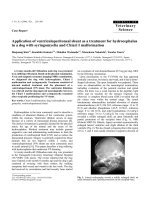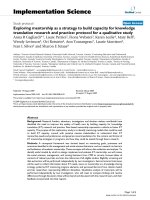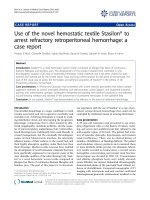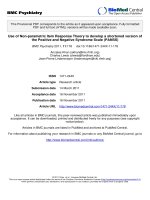Use of coconut shell as natural adsorbent to treat wastewater containing hazardous insecticide compound and its toxicity test on nile tilapia
Bạn đang xem bản rút gọn của tài liệu. Xem và tải ngay bản đầy đủ của tài liệu tại đây (1.36 MB, 64 trang )
THAI NGUYEN UNIVERSITY
UNIVERSITY OF AGRICULTURE AND FORESTRY
AMANA AMALIA
USE OF COCONUT SHELL AS NATURAL ADSORBENT TO TREAT
WASTEWATER CONTAINING HAZARDOUS INSECTICIDE COMPOUND
AND ITS TOXICITY TEST ON NILE TILAPIA
BACHELOR THESIS
Study Mode
: Full-Time
Major
: Environmental Science and Management
Faculty
: Advanced Education Program
Batch
: 2014 - 2018
Thai Nguyen, September 2018
i
DOCUMENTATION PAGE WITH ABSTRACT
Thai Nguyen University of Agriculture and Forestry
Degree Program
Bachelor of Environmental Science and Management
Student Name
Amana Amalia
Student ID
DTN1454290075
Thesis Title
Use of Coconut Shell as Natural Adsorbent to Treat
Wastewater Containing Hazardous Insecticide Compound and
Its Toxicity Test on Nile Tilapia
Supervisor (s)
Dr.-phil. Dipl.-Ing.agr. Arinafril
Prof. Tran Van Dien
Abstract:
To investigate the effects of environmental contaminants, this study explored the
adsorption capacity of Coconut (Cocos nucifera L.) shell towards cypermethrin in
aqueous solutions. The purpose of the present study is to evaluate the ability of
coconut shell, to alleviate cypermethrin from wastewater and to assess the
histopathological alterations in the gills of Nile Tilapia (Oreochromis niloticus) which
were kept in histopathological alterations would contribute an important role in
assessing the harmful effects of cypermethrin. Histopathological response of fish
exposed to pollutants has been used as (a) sensitive biomarkers. Histopathological
examination on fish gill indicates that excessive levels of cypermetrhin can damage
the tissues of the fish gills. The alterations detected were as Telengeactacia, Fusion of
i
Secondary Lamellae, Epithelial Proliferation of Secondary Lamellae, Congestion and
Curling Bend.
Keywords
Coconut Shell, Histopathology, Oreochromis niloticus,
Cypermethrin, Wastewater, Natural Adsorbent
Number of Pages
55
Date of Submission
26/09/2018
Supervisor’s Signature
ii
ACKNOWLEDGEMENT
From the deepest feeling in my heart, I would like to say Thank You for all the
people who always support me and thank you to Allah SWT who has given his grace so
that I could finish this thesis.
First, I would like to send my sincere gratitude to Dr.-phil. Dipl.-Ing.agr.
Arinafril of Sriwijaya University, Indralaya, Indonesia as my first supervisor, Prof. Tran
Van Dien of Thai Nguyen University, Vietnam as my second supervisor and Krisna
Murti, MD., M. Biotech. Stud., Ph.D. in the Department of Anatomical Pathology,
Faculty of Medicine, Sriwijaya University who assisted and helped me patiently in
histopathological examination and also during my thesis writing.
I also would like to thank all parties who have supported and assisted in the
preparation of this thesis especially to:
1. Prof. Dr. Ir. H. Anis Saggaf, MSCE as the Rector of Sriwijaya University, Palembang,
Indonesia
2. Prof. Dr. Ir. Andy Mulyana, M.Sc. as the Dean of Faculty of Aquaculture, Sriwijaya
University, Palembang, Indonesia
3. Prof. Dade Jubaedah, S.Pi., M.Si. from Faculty of Aquaculture, Sriwijaya University
as a companion lecturer who has kindly accompanied me and guided me when I
implemented this research
4. Prof. Mochamad Syaifudin, S.Pi., M.Si. from Faculty of Aquaculture, Swirijaya
University, Palembang, Indonesia
iii
5. Prof. Dr. Mohammad Amin, S.Pi., M.Si. Faculty of Aquaculture, Sriwijaya
University, Palembang, Indonesia
6. Mrs. Nurhayani as lab analyst from Laboratory of Aquaculture, Sriwijaya University
who helped, assisted me and gave some advises during my research
7. Mrs. Ana and Mrs. Naomi as lab analyst from Laboratory of Fisheries Product of
Technology, Sriwijaya University
8. Other staffs and friends from Aquaculture Sriwijaya University who helped and
assisted me during my research
In addition, I would like to express my deepest thanks to my friends who always
give me their love, support and advises.
Finally, special thanks to my parents and my family for their support throughout
my study.
Sincerely,
Amana Amalia
iv
TABLE OF CONTENTS
LIST OF FIGURES .................................................................................................... vii
LIST OF TABLES ..................................................................................................... viii
PART I. INTRODUCTION .......................................................................................... 1
1.1. Background and Rationale ..................................................................................... 1
1.2. Objectives .............................................................................................................. 4
1.3. Research Questions and Hypotheses ..................................................................... 4
1.3.1. Research Questions ............................................................................................. 4
1.3.2. Hypotheses .......................................................................................................... 5
1.4. Limitations ............................................................................................................. 5
PART II. LITERATURE REVIEW ............................................................................. 6
2.1. Cypermethrin Compound ...................................................................................... 6
2.2. Toxic Effect of Cypermethrin on Organisms ........................................................ 7
2.2.1. Toxicity ............................................................................................................... 7
2.2.2. Histopathological Effects .................................................................................. 10
2.3. Test Species – Oreochromis niloticus .................................................................. 12
2.3.1. Scientific classification ..................................................................................... 12
2.4. Coconut Shell ....................................................................................................... 12
2.5. Activated Carbon ................................................................................................. 14
2.6. Single Drum Carbonization ................................................................................. 15
2.7. Activation of Activated Carbon ........................................................................... 16
PART III. MATERIALS AND METHODS .............................................................. 21
3.1. Place and Time ..................................................................................................... 21
v
3.2. Equipments and Materials ................................................................................... 21
3.3. Methods................................................................................................................ 22
3.3.1. Fish Preparation ................................................................................................ 22
3.3.2. Toxicity Testing ................................................................................................ 22
3.3.3. Adsorbent Preparation ...................................................................................... 23
3.3.4. Ash Content Analysis ....................................................................................... 24
3.3.5. Water Content Analysis .................................................................................... 24
3.3.6. Adsorbent Experiment Using Fish as Bio indicator ......................................... 25
3.3.7. Histopathological Examination......................................................................... 26
PART IV. RESULTS AND DISCUSSIONS ............................................................. 29
4.1. Results .................................................................................................................. 29
4.1.1. Preliminary Test LC50 Determination ............................................................... 29
4.1.2. Ash Content Analysis ....................................................................................... 30
4.1.3. Water Content Analysis .................................................................................... 31
4.1.4. Adsorbent Experiment using Fish as Bio Indicator .......................................... 31
4.1.5. Histopathological Observation of Gills ............................................................ 37
4.2. Discussions .......................................................................................................... 44
PART V. CONCLUSION ........................................................................................... 48
REFERENCES ........................................................................................................... 49
APPENDICES ............................................................................................................ 53
vi
LIST OF FIGURES
Figure 1. Coconut Shell ................................................................................................ 13
Figure 2. The Condition of Aquarium after 24 hours of Adsorbent Additional Process
....................................................................................................................................... 32
Figure 3. Normal histological gills structure ................................................................ 37
Figure 4. Histopathological alterations of gills structure of Nile Tilapia treated by
using 3.8 ml/L of cypermethrin concentration without adsorbent treatment ....... 38
Figure 5. Histopathological alterations of gills structure of Nile Tilapia treated by
using 3.1 ml/L of cypermethrin concentration with adsorbent treatment ............ 39
Figure 6. Histopathological alterations of gills structure of Nile Tilapia treated by
using 3.4ml/L of cypermethrin concentration with adsorbent treatment ............. 40
Figure 7. Histopathological alterations of gills structure of Nile Tilapia treated by
using 3.8ml/L of cypermethrin concentration with adsorbent treatments ........... 41
Figure 8. Histopathological alterations of gills structure of Nile Tilapia treated by
using 4.2 ml/L of cypermethrin concentration with adsorbent treatment ............ 42
Figure 9. Histopathological alterations of gills structure of Nile Tilapia treated by
using 4.6ml/L of cypermethrin concentration with adsorbent treatment ............. 43
vii
LIST OF TABLES
Table 1. Physical and Chemical Properties of Cypermethrin ......................................... 6
Table 2. Toxicity Classification of Cypermethrin .......................................................... 8
Table 3. Characterization of Activated Carbon (SII. 0258-88) .................................... 15
Table 4. Equipments for Toxicity and Adsorbent Test ................................................. 21
Table 5. Materials for Toxicity and Adsorbent Test ..................................................... 22
Table 6. Effect of Cypermethrin Concentration on Nile Tilapia in Preliminary Test .. 29
Table 7. Effect of Cypermethrin on Nile Tilapia in Five Repetitions using Adsorbent
Treatments ............................................................................................................ 32
Table 8. Observation of Cypermethrin Effect on Nile Tilapia ..................................... 35
viii
PART I. INTRODUCTION
1.1. Background and Rationale
Along with the extensive increasing of coconut industrial making the waste
production is higher. This will certainly cause some negative impact to the environment
if it is not managed and utilized wisely. Environmental damage caused by technological
advancement using substances is very dangerous to living things. Furthermore, it will
disturb the ecological balance. Basically, most of environmental damages are an impact
of human activities, especially those that occurred to be water pollution. The
contamination of water pollution tends to disrupt and destroy the fragile ecology through
indiscriminate discharge of industrial and municipal waste into the sea. The
contamination affects not only the surrounding area but also indirectly for human health.
Most of industrial waste dumped into the water leads to extinction of living things. The
composition of industrial waste cannot be characterized readily by a typical range of
values because its makeup is depended on the type of manufacturing process involved
(Kurniati, 2008). Sewage, industrial waste and agricultural chemicals, such as fertilizers
and pesticides, are the main causes of water pollution. Among those wastes, insecticides
are the most widely used in agricultural activity, one of them is cypermetrhin (Sarikaya,
2009).
Cypermethrin is a class of pyrethroid insecticides. Pyrethroid is a group of plantprotection products that are widely used as insecticides in agricultural settings, gardens
and industrial areas. Furthermore, they are used to treat ectoparastic diseases (e.g., lice)
in sheep, cats, dogs, and other animals. They are structurally similar to pyrethrins, a
class of compounds that are found in chrysanthemum plants, where they work as natural
1
insecticides. In this past 25 years, pyrethroids have become one of the most dominant
class of insecticides in agriculture because of their low toxicity on mammals and reduced
application rates. Because of these properties, organophosphates and carbamates are
increasingly being replaced by pyrethroids in arable crops and forestry throughout
Europe and North America (Hartnik, Sverdrup and Jensen, 2008).
In the recent years, water pollution caused by insecticide compound has been a
serious problem in developing country that runs farming system as their major
opportunity to raise money. Generally, pyrethroid insecticides are used extensively in
agriculture and have resulted as the cause of increasing level of toxic chemicals in an
aquatic environment. Cypermethrin, one of insecticides from pyrethroid group, is
known as the highest toxic synthetic insecticide which can kill insects by strong
excitement in their nervous system. It is often transported to surface waters via runoff
and erosion as well as the drift from aerial sprays. Consequently, it could be dangerous
to benthic and epi-benthic species, as well as fish and other organisms feeding on
benthos (Richterova et al., 2015). Due to the high toxicity to aquatic organisms, the
usage of cypermethrin is restricted for crops and wide area applications (Sarikaya,
2009). Histopathological response of fish exposed to pollutants has been used as the
sensitive biomarkers.
One of the efforts to mitigate cypermethrin insecticide residues is to use activated
charcoal whose ingredients can come from agricultural waste, such as coconut shells.
The relative increasing of technological development of coconut in Indonesia makes the
production of coconut waste higher. One of the wastes produced by the coconut is the
shell. Dried coconut shell contains 33.61% cellulose, 36.51% lignin, 29.27% pentosans
and 0.61% ash (Shelke et al., 2014). The contents make the coconut shell are possibly
2
used as raw material for making activated carbon or activated charcoal. According to
Ratnoji and Singh (2014), coconut shells have high carbon content and hardness which
make coconut shells an excellent raw material source to produce activated carbon which
are very effective to adsorb the waste. The use of activated charcoal in rice fields able
to increase the number of bacteria and nitrogen fixation bacteria (Azotobacter) in the
soil, especially around the roots of food crops. Activated charcoal from coconut shell
increases the microbial population of Citrobacter sp, Enterobacter sp, and Azotobacter
sp in rice cultivation which is where some of these bacteria include pesticide degrading
bacteria and nitrogen fixers. The use of activated charcoal in the cultivation of
agricultural crops can reduce insecticide residues in soil, water, and agricultural
products. The direct benefit of using activated charcoal from coconut shells on
agricultural land is that it can help to reduce surface water pollution in rivers that can
disrupt the life of aquatic organisms and human health, reduce insecticides and heavy
metals residues in agricultural products, reduce agricultural waste and provide added
value from agricultural waste (Harsanti et al., 2013).
Fish have been considered as good bio-accumulators of organic and inorganic
toxicants. Fish are primary sources of protein. They comprise large components of most
aquatic environment functioning as bio-indicator of heavy metal contamination in the
aquatic ecosystem. Oreochromis niloticus is one of the most favoured common fish
species among aqua-culturists. It has a comparative advantage, such as ability to tolerate
a wide range of environmental conditions, fast growth, successful reproductive
strategies, and ability to feed at different trophic levels, which make it becomes an
important commodity of aquaculture. These same traits allow them to be an extremely
successful invasive species in subtropical and temperate environments (Grammer et al.,
3
2012). On the other hand, people are also affected by eating fish especially those areas
where main food is fish. Terrestrial and aquatic food chains are suitable for
accumulating numerous environmental pollutants up to levels that could be toxic to both
anthropogenic and aquatic organisms’ health.
Fish as one of the biotas of water that can be used as an indicator of the level of
water pollution. Histopathological analysis of fish can be used as a biomarker to monitor
marine environment through observations of fish health. The observations can be done
on the organs which functions are important in the metabolism. So, it can be used as an
early diagnosis of illness in fish (Zulfahmi, Affandi and Lumban Batu, 2015). One of
the freshwater fishes which sensitive to water pollution is Nile Tilapia.
In addition, to face the problem related to the impact of water pollution caused by
hazardous waste content such as insecticides. This study explored the effective role of
coconut shell as activated carbon in reducing the impact of cypermethrin to the water
through fish which could be seen by histopathological analysis.
1.2. Objectives
This study was designed to analyse the toxicological effects of cypermethrin on
Nile Tilapia and see the effectiveness of coconut shell to adsorb the pollutant as well as
to reveal the histopathological alterations on Nile Tilapia gills under different
concentrations of cypermethrin and adsorbent treatment.
1.3. Research Questions and Hypotheses
1.3.1. Research Questions
The pollution problem caused by the contaminants of insecticide in the waters has
been attempted in this study using an adsorbent material derived from waste biomass
such as coconut shell. Problems are as follows:
4
1. How does cypermethrin affect the gills of Nile Tilapia?
2. How does cypermethrin affect the gills of Nile Tilapia after adsorbent is given?
1.3.2. Hypotheses
Hypotheses Question 1:
H0 (Null Hypotheses): Exposure to cypermethrin contamination with the treatment
of adsorbent will not result in changes in gills histology of Oreochromis niloticus.
HA (Alternative Hypotheses): Exposure to cypermethrin contamination with the
treatment of adsorbent will result in changes in gills histology of Oreochromis niloticus.
Hypotheses Question 2:
H0 (Null Hypotheses): Exposure to cypermethrin contamination with the
treatment of adsorbent will not result in changes in gills histology of Oreochromis
niloticus after adsorbent is given.
HA (Alternative Hypotheses): Exposure to cypermethrin contamination with the
treatment of adsorbent will result in changes in gills histology of Oreochromis niloticus
after adsorbent is given.
1.4. Limitations
-
There is a lack of experimental methodology using coconut shell as an
adsorbent to adsorb cypermethrin insecticide
-
An uncertain fish conditions affects the time of the toxicity testing and
adsorbent experiment
-
As well, the lack of experimental results on the histopathological effects on the
gills tissue of Nile Tilapia which caused by cypermethrin in literature
5
PART II. LITERATURE REVIEW
2.1. Cypermethrin Compound
In Table 1 shows the physical and chemical properties of cypermethrin insecticide.
Table 1. Physical and Chemical Properties of Cypermethrin
Cyano(3-phenoxyphenyl)methyl 3-(2,2Chemical Name
dichloro ethenyl)-2,2dimethylcyclopropanecarboxylate
Common Name
Cypermethrin
Arrivo, Cymbush, Cymperator, Cynoff,
Trade Names
Ripcord, Basathrin, Demar, Grand, Starcyp
Chemical Formula
C22H19Cl2NO3
Chemical Structure
CAS Registry Numbers
52315-07-8
Molecular Weight
416.3
Density, g/cm3 at 25oC
1.25
Physical State
Viscous semi-solid
Melting Point oC
80.5
6
Solubility
0.004 (20 0C) Soluble
Vapor Pressure
3.07x10-9(20oC)
Octanol/Water Partition
6.6
Coefficient
Henry’s Law Constant
4.2x10-7d
Conversion Factors
1mg/m3 = 0.059ppm
pH
7 and below (in water)
Source: USDA, 2001; Tomlin, 1997
2.2. Toxic Effect of Cypermethrin on Organisms
2.2.1. Toxicity
The toxicity classification of cypermethrin via the designated routes of exposure shows
in Table 2.
7
Table 2. Toxicity Classification of Cypermethrin
Pathway of Exposure
Inhalation
Mechanism
The respiratory irritation is one of the
major effects of inhalation exposures by
directly spraying and getting involved in
the packing of the cypermethrin will have
symptoms
such
as
hypersensitivity,
neumonistic, pleuritic chest pain, nonproductive cough and shortness of breath.
Ingestion
Ingestion of food contaminated by
cypermethrin
insecticide
effects
on
human will have symptoms such as
nausea, diarrheal, vomiting and epigastric
pain or even death.
Dermal
Allergic symptoms shown from dog’s
skin by washing with shampoo which
contains cypermethrin and skin irritation
such as burning, numbness and itching
which farmers used it as based plant.
Source: Javed et al., 2015
Cyano(3-phenoxyphenyl)methyl3–(2,2–dichloroethenyl)–(2,2
dimethylcyclopropanecarboxylate) which has known as cypermethrin is an active
8
substance one of type II synthetic pyrethroid insecticide similar to natural pyrethrin
isolated from chrysanthemum flowers, which has high insecticidal activity (ATSDR,
2003). Cypermethrin is an active pyrethroid, which intensively controls a wide range of
pests in agriculture and animal breeding. Cypermethrin is classified as a schedule 6
poison in the standard for the Uniform Scheduling of Drugs and Poisons. Most technical
grades of cypermethrin contain more than 90% of the active material. Cypermethrin has
a very low vapour pressure and solubility in water, but it is highly soluble in a wide
range of organic solvents. Analytical methods are available for the determination of
cypermethrin in commercially available preparations. In addition, methods for the
determination of residues of cypermethrin in foods and in the environment are well
established. Cypermethrin is relatively safe to mammals and birds, but is extremely toxic
to fish and aquatic organisms, and should not be applied on or near water, or when drift
is a possibility (Sarikaya, 2009).
Cypermethrin is not soluble in water and adsorbed extensively and rapidly in
water-sediment systems. According to WHO (1989) cypermethrin was synthesized in
1974 and first marketed in 1977 as a highly active synthetic pyrethroid insecticide,
effective against a wide range of pests in agriculture, public health, and animal
husbandry. In agriculture, cypermethrin is among the most widely sold pyrethroids as it
is heavily used to replace the more toxic organophosphates. Its main use is against
foliage pests and certain surface soil pests, such as cutworms, but because of its rapid
breakdown in soil, it is not recommended for use against soil-borne pests below the
surface.
Cypermethrin used to control many pests including lepidopterous pests of cotton,
fruit, and vegetable crops and is available as an emulsify-able concentrate or wet-able
9
powder. As a result of its numerous applications, the potential of cypermethrin discharge
into aquatic environment has increased. When cypermethrin get into the water it will
disrupt into the environment of aquatic biota such as fish. Fish can show reaction to the
physical changes of water as well as pollutant compounds dissolved in accordance with
the limits of concentration certain. This is one of the reasons why fish can be utilized as
a biota in biological tests (Authman et al., 2015).
2.2.2. Histopathological Effects
There are several studies on histopathological effects of cypermethrin on
organisms. Histopathological alterations give a reliable, efficient measurable index of
low-level toxic stress to a wide range of environmental contaminants.
Ojutiku et al (2014) conducted a research on the toxicity and histopathological
effects of cypermethrin on juveniles of Clarias gariepinus. In this experiment the fish
were exposed to six acute concentrations (0.025mg/l, 0.050mg/l, 0.075mg/l, 0.100mg/l,
0.125mg/l and 0.000mg/l) for 96 hours. The 96 hours LC50 of the toxicant to the test fish
was 0.060mg/L. The most common gill changes at all doses of cypermethrin in solution
were destruction of gill lamella, epithelial hyperplasia and epithelial hypertrophy. Fish
gills treated with the lowest concentration of cypermethrin showed gill necrosis,
congestion, cartilage and interstitial haemorrhages while in the highest concentration of
cypermethrin the treated gills showed a severe gill necrosis with extensive vacuolation
within the epithelia of the gills, infiltration, cartilage and interstitial haemorrhages were
also found.
Rahayu,
Zulfatin
and
Nuriliani
(2001)
conducted
a
research
about
histopathological test of gill tissue, liver and intestine towards Nile Tilapia using λcyhalothrin as pollutant. The variations concentration of λ-cyhalothrin were 3, 6, 9 and
10
12 μg/L using 5 treatments and 3 repetitions where each of aquariums filled with 10 Nile
tilapia and 10L of water. As the results obtained, there were found some damages
include the gill tissue, liver and intestine of Nile Tilapia. Gills damages were in the form
of hyperplasia, necrosis, edema, secondary lamella fusion, removal of lamella epithelial
cells, and primary lamella dilatation. Liver damages include hemorrhage, intravascular
hemolysis on blood vessels, piknosis, and leukocytes infiltration. The intestine damages
were fatty degeneration, edema, leukocyte infiltration, hemorhage, cloudy swelling,
vacuolisation, necrosis, and arthropy. The gills, liver, and small intestine damages of
Nile Tilapia range from slight to severe. It could be concluded that λ-cyhalothrin caused
histopathological effects on the gills, liver, and small intestine of Nile Tilapia. Then,
continue with study of the effects of cadmium (Cd) on the structures of the gills of catfish
(Clarias batrachus). If the fish were exposed to 0 (control), 1, 2, and 4 ppm of Cd
during 14 days, showed that Cd affected the structure of the gills of catfish, such as
edema, hyperplasia, and fusion gill lamella. Damage could be happened as the
concentration of cadmium is increasing in media. The gills of control animals showed
the lowest damage (13.9%), whereas the level of gill damage of fish exposed to 1, 2,
and 4 ppm were 45.7; 71.6; and 82.1% respectively (Hayati, Ummah and Winarni,
2016).
Histopathological changes due to some chlorinated hydrocarbon pesticides in the
tissues to Cyprinus carpio performed by using the concentration of Aldrin, Dieldrin,
BHC and DDT. The concentrations of pollutants were varied from 0.005, 0.002, 1.000
and 0.002 mg L-1 respectively. The test fish were kept in the test solution of known
concentration for a period extending over to 20 and 30 days. After every 24 hours fresh
test solution was introduced. The experiments were run in replicates for all pesticides.
11
Histopathological changes were observed in vital organs such as damages in gills
showed swelling and thickening in their filaments, liver showed abnormal fatty
degeneration and kidney tissue showed large vacuolated cells were seen in the glomeruli
(Satyanarayan et al., 2012).
2.3. Test Species – Oreochromis niloticus
2.3.1. Scientific classification
Kingdom
: Animalia
Phylum
: Chordata
Class
: Actinopterygii
Order
: Perciformes
Family
: Cichlidae
Genus
: Oreochromis
Species
: O. niloticus
Binomial name
: Oreochromis niloticus (Linnaeus, 1758)
Oreochromis niloticus is one of the mostly favored common fish species among
aquaculturists. It has a comparative advantage which makes it becomes an important
commodity of aquaculture because of its ability to tolerate a wide range of
environmental conditions, fast growth, successful reproductive strategies, and ability to
feed at different trophic levels. These same traits allow them to be an extremely
successful invasive species in subtropical and temperate environments (Grammer et al.,
2012).
2.4. Coconut Shell
Coconut plantation industry is one of the most popular sectors in society in
Indonesia even the world. The processing of coconut itself has many processes which
12
each of process will certainly produce waste. One of the wastes which usually produce
from the coconut is coconut shell.
Figure 1. Coconut Shell
Coconut shells are one of the sludge-by products of coconut processing industry, which
currently creates problems for the environment. This is because the waste is produced
in large quantities and difficult to degrade or decompose naturally in the environment.
Dried coconut shell contains 33.61% cellulose, 36.51% lignin, 29.27% pentosans and
0.61% ash (Shelke et al., 2014). With the content of coconut shells which are very
possible to be used as raw material for making activated carbon or activated charcoal.
Coconut shells have high carbon content and hardness which make coconut shells as an
excellent raw material source to produce activated carbons which are very effective to
adsorb the waste. Activated coconut shell charcoal on the ground cabbage cropping can
reduce chlorpyrifos insecticide residues in water to about 50%, lindan and aldrin residual
levels on mustard plants which are given activated charcoal from the shell are relatively
high (Ratnoji and Singh, 2014).
13
2.5. Activated Carbon
Activated carbon is a form of carbon species that is processed and prepared to have
high porosity and very large surface area available for adsorption. Coconut shell is
suitable for preparing micro porous activated carbon due to its excellent natural structure
and low ash content. Activated carbon can be activated either chemically or physically
(Hanum, 2009). The advantages of coconut shell carbons including high density and
high purity. They are virtually dust-free, since they are harder and more resistant to
attrition. Activated carbon is used in gas purification, gold purification, metal extraction,
water purification, medicine, sewage treatment, air filters in gas masks and respirators,
filters in compressed air and many other applications (Sangotayo et al., 2017).
There are some characteristics to determine whether the activated carbon is good
or not according to SII. 0258-88 as can be seen in Table 3.
14
Table 3. Characterization of Activated Carbon (SII. 0258-88)
No
Description
Unit
Characteristics
1
Air Content
%
Max 10
2
Ash Content
%
Max 10
3
The missing part on the heating of
Max 25
950oC
%
4
Adsorption of I2
Mg/gram
Min 750
5
Pure Activated Carbon
%
Min 65
6
Adsorption of Methylene Blue
Ml/gram
7
Speed of Bulk Type
g/ml
Min 120
0.30-0.35
Source: Scientific Communication and Information Center, 1997
2.6. Single Drum Carbonization
Carbonization is a pyrolysis process or incomplete combustion (without oxygen) to
the base material used to obtain charcoal with carbonization temperature depending on
the base material. The most important and most influential stage of charcoal quality is
the process of burning and turning out fires. At the combustion in the way that people
usually do, the combustion process is thorough and constantly uncontrolled so that the
burned shell first becomes charcoal, will continue to burn following the unburned shell.
As a result, many shells become ash and others have not been burned so that the low
yield of charcoal is 22.5% (Lindayanti, 2006).
15
In combustion with a controlled air supply system, the combustion process is
controlled by regulating the air supply into the combustion tube. In the burned shell
portion of the charcoal, the air supply hole is closed and the opening in the top row is
opened so that the combustion process only takes place in the portion where the air
supply hole is open. And so on until the air hole on the top row. Thus, in the charcoal of
combustion results not found ash and very little shell that does not become charcoal so
that the yield of charcoal produced higher, i.e. 31.58%.
2.7. Activation of Activated Carbon
There are some methods for activation of activated carbon, which by chemically,
physically or physic-chemical activation. Each of the methods has their own advantages
and disadvantages so we can adjust to the needs.
16









